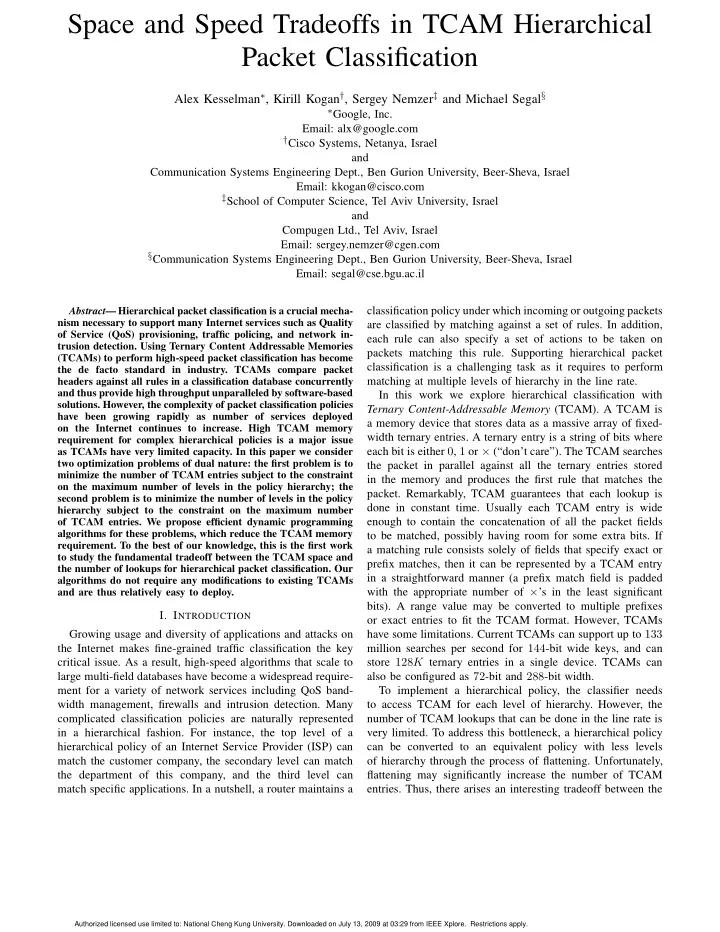

Space and Speed Tradeoffs in TCAM Hierarchical Packet Classification Alex Kesselman ∗ , Kirill Kogan † , Sergey Nemzer ‡ and Michael Segal § ∗ Google, Inc. Email: alx@google.com † Cisco Systems, Netanya, Israel and Communication Systems Engineering Dept., Ben Gurion University, Beer-Sheva, Israel Email: kkogan@cisco.com ‡ School of Computer Science, Tel Aviv University, Israel and Compugen Ltd., Tel Aviv, Israel Email: sergey.nemzer@cgen.com § Communication Systems Engineering Dept., Ben Gurion University, Beer-Sheva, Israel Email: segal@cse.bgu.ac.il Abstract — Hierarchical packet classification is a crucial mecha- classification policy under which incoming or outgoing packets nism necessary to support many Internet services such as Quality are classified by matching against a set of rules. In addition, of Service (QoS) provisioning, traffic policing, and network in- each rule can also specify a set of actions to be taken on trusion detection. Using Ternary Content Addressable Memories packets matching this rule. Supporting hierarchical packet (TCAMs) to perform high-speed packet classification has become classification is a challenging task as it requires to perform the de facto standard in industry. TCAMs compare packet headers against all rules in a classification database concurrently matching at multiple levels of hierarchy in the line rate. and thus provide high throughput unparalleled by software-based In this work we explore hierarchical classification with solutions. However, the complexity of packet classification policies Ternary Content-Addressable Memory (TCAM). A TCAM is have been growing rapidly as number of services deployed a memory device that stores data as a massive array of fixed- on the Internet continues to increase. High TCAM memory width ternary entries. A ternary entry is a string of bits where requirement for complex hierarchical policies is a major issue each bit is either 0 , 1 or × (“don’t care”). The TCAM searches as TCAMs have very limited capacity. In this paper we consider two optimization problems of dual nature: the first problem is to the packet in parallel against all the ternary entries stored minimize the number of TCAM entries subject to the constraint in the memory and produces the first rule that matches the on the maximum number of levels in the policy hierarchy; the packet. Remarkably, TCAM guarantees that each lookup is second problem is to minimize the number of levels in the policy done in constant time. Usually each TCAM entry is wide hierarchy subject to the constraint on the maximum number enough to contain the concatenation of all the packet fields of TCAM entries. We propose efficient dynamic programming algorithms for these problems, which reduce the TCAM memory to be matched, possibly having room for some extra bits. If requirement. To the best of our knowledge, this is the first work a matching rule consists solely of fields that specify exact or to study the fundamental tradeoff between the TCAM space and prefix matches, then it can be represented by a TCAM entry the number of lookups for hierarchical packet classification. Our in a straightforward manner (a prefix match field is padded algorithms do not require any modifications to existing TCAMs with the appropriate number of × ’s in the least significant and are thus relatively easy to deploy. bits). A range value may be converted to multiple prefixes I. I NTRODUCTION or exact entries to fit the TCAM format. However, TCAMs have some limitations. Current TCAMs can support up to 133 Growing usage and diversity of applications and attacks on million searches per second for 144 -bit wide keys, and can the Internet makes fine-grained traffic classification the key store 128 K ternary entries in a single device. TCAMs can critical issue. As a result, high-speed algorithms that scale to also be configured as 72 -bit and 288 -bit width. large multi-field databases have become a widespread require- ment for a variety of network services including QoS band- To implement a hierarchical policy, the classifier needs width management, firewalls and intrusion detection. Many to access TCAM for each level of hierarchy. However, the complicated classification policies are naturally represented number of TCAM lookups that can be done in the line rate is in a hierarchical fashion. For instance, the top level of a very limited. To address this bottleneck, a hierarchical policy hierarchical policy of an Internet Service Provider (ISP) can can be converted to an equivalent policy with less levels match the customer company, the secondary level can match of hierarchy through the process of flattening. Unfortunately, the department of this company, and the third level can flattening may significantly increase the number of TCAM match specific applications. In a nutshell, a router maintains a entries. Thus, there arises an interesting tradeoff between the Authorized licensed use limited to: National Cheng Kung University. Downloaded on July 13, 2009 at 03:29 from IEEE Xplore. Restrictions apply.
Recommend
More recommend